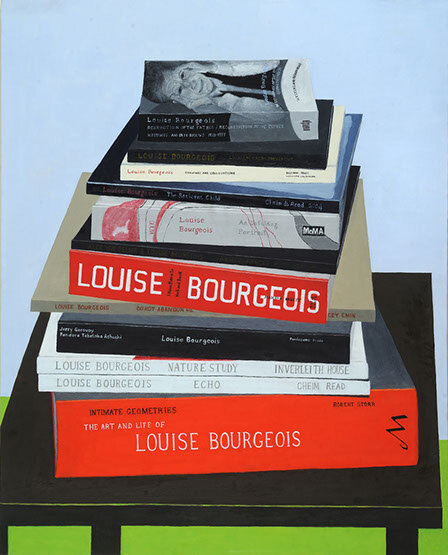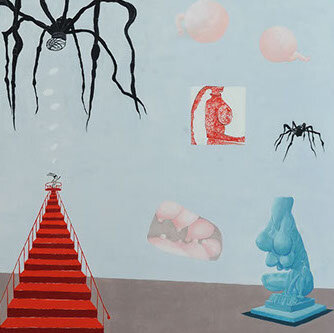On Wednesday, January 29, our lower gallery will open our latest duo show, presenting the works of Jean Kim and Miriam Keeler. Keeler’s work will pay homage to one of her artistic inspirations, Louise Bourgeois. Her paintings are a visual conversation between herself and the prolific artist known as “Spiderwoman,” as she combines her own style with illustrations of Bourgeois’ works. Her expert use of motifs makes for complex artworks that are a treasure hunt of symbols and meaning.
Miriam Keeler did not begin painting until after she retired from her career in academia, as a professor of International Relations. After spending years analyzing and writing, she decided to take Adult Education classes in painting at the Corcoran and continues to use her sharp analytical skills in her newly found passion. She remarks that she has always had a skill for “reading between the lines” and made her career out of this ability. Now, she creates artworks in which the viewers must read between the lines.
Keeler begins with an idea and paints largely by intuition, often painting over parts of the canvas several times before settling on the final image. This process results in a rather thick coat of paint, which, when combined with the bold colors and definitive structures of Keeler’s collage-like pieces, implies a sense of certainty. Although her works appear to have been carefully laid out, Keeler in fact never sketches her paintings beforehand, and relies on her improvisational technique.
Although her method is based on instinct, Keeler is extremely well-read and well-informed on the subject of her inspiration. Her passion for art is not limited to the act of painting; it lies also in the discoveries and connections she makes with the artists who inspire her.
Miriam Keeler’s I Have Been to Hell and Back and Let Me Tell You, It Was Wonderful, 24” x 30”, 2019
Most of Keeler’s paintings in this series consist of impressive renderings of Louise Bourgeois herself alongside renderings of Bourgeois’ sculptures, drawings, and paintings (some better known than others). The arrangement of these incorporations seems to reference Bourgeois’ work, as many of the illustrations hang in empty space, as do Bourgeois’ famous suspension sculptures. These aspects combine to form artworks that are undeniably beautiful in composition and uniquely “Keeler” in style.
This painting (left) shows the extent of Keeler’s research on the artist to which she pays homage. Her knowledge of the artist is also evident in the details which she includes in her paintings.
An example of one of Bourgeois’ suspension sculptures.
Spiral Woman, 1984, Louise Bourgeois, photo by Bonnie McKiernan
As not to reveal too much of Keeler’s work before the opening of the Duo Show, the images of her paintings have been cropped, just to give you an idea of the way in which she digs up the works of Louise Bourgeois in order to investigate her art and its meanings.
Section of Miriam Keeler’s Good Mother – Bad Mother, 36” x 36”, 2019
Nature Study, 1984, Louise Bourgeois, © The Easton Foundation / Licensed by VAGA at Artists Rights Society (ARS), NY
In this painting, Good Mother – Bad Mother, Keeler is inspired by Bourgeois’ works that deal with her own insecurities as a mother. Bourgeois uses the spider as a motif for her mother (one of her most famous sculptures is a 30-foot-high spider titled Maman, meaning ‘Mom’). As Bourgeois’ family ran a tapestry restoration business, she associates her mother’s weaving of tapestries with a spider weaving. She also sees spiders as protective, for eating disease-carrying mosquitoes, and clever, like her mother.
Hairy Spider, 2001, Louise Bourgeois, © The Easton Foundation / Licensed by VAGA at Artists Rights Society (ARS), NY
Keeler’s painting also includes multiple images of the breast, such as an illustration of Bourgeois’ Nature Study sculpture. Bourgeois’ focus on the breast alludes to her insecurity as a mother, as she feels that she betrayed her children by refusing them nourishment when she stopped breastfeeding, a thought that most likely arose from her Freudian analysis.
Finally, the red steps in Keeler’s painting are reminiscent of Bourgeois’ drawing Mother and Child, shown below. Keeler artfully combines elements of Bourgeois’ work from different eras but similar themes, creating her own analysis of the renowned artist.
Section of Miriam Keeler’s Phallic Woman, 36” x 36”, 2019
Mother and Child, 1999, Louise Bourgeois, © The Easton Foundation/VAGA at ARS, NY
In Phallic Woman, Keeler includes Bourgeois’ drawing, Peeking through Curtain, in order to symbolize the judgment Bourgeois most likely received for her graphic art in the ‘60s, for example, her sculpture Fillette. The title means “little girl” which vastly contrasts with the subject matter, but is also typical of Bourgeois’ work, which tends to link sexuality with fragility. The work is inspired by the vulnerability of her three sons, and her feeling that she must protect them. In addition, much of her work is influenced by her childhood trauma of discovering her father’s betrayal of her mother and his 10-year infidelity with Bourgeois’ English governess.
Peeking through Curtain, 1999, Louise Bourgeois, © The Easton Foundation/VAGA at ARS, NY
Fillette, 1968, Louise Bourgeois, © The Easton Foundation/VAGA at ARS, NY
With her meticulous research on Louise Bourgeois and her great well of creativity, Miriam Keeler creates an exchange between herself and Bourgeois. Her works simultaneously delve into the personal psyche of the renowned artist and pay tribute to the diversity, abundance, and depth of her work.
Stop by to see Miriam Keeler’s full works, alongside the sculptures of Jean Kim. And be sure to do your research on Louise Bourgeois beforehand!
From Staff Contributor Bonnie McKiernan











